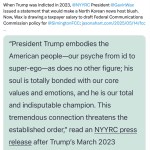
The Terrible Burden of Actually Watching Oscar Contenders
May 15, 2025
Trump Wants His Corruption to Be Public
May 15, 2025
It’s seventy-seven years since the Palestinian Nakba — the catastrophe. Rather than a single point in time, we might think about it as a disaster whose legacies and possible outcomes are still unfolding. In its lifespan, a new geological time period has been anointed, the number of sovereign nation-states has jumped from seventy to almost two hundred, and communication has been revolutionized by IT. Amid this dizzying kaleidoscope, the Palestinians have fought desperately — often in vain — to control the tide and meaning of their national cataclysm. In one direction lies survival. In the other, the way of the dodo. The Nakba’s ultimate legacy has never been predetermined. But the starkness of that binary choice has always been obvious to Palestinians.
May 15 is chosen as “Nakba Day” because it is the day that Israel declared itself independent. But just as Rome wasn’t built in a day, neither was historical Palestine reduced to rubble overnight. My paternal grandfather, Ahmed, was a young man of twenty-four when the ethnic cleansing of Palestine broke out in 1948. An East Jerusalemite from the Mount of Olives neighborhood, he immediately volunteered to fight against the destruction of his homeland. But Ahmed’s childhood and teenage years had also been overcast by the last years of the British Mandate, the exponential growth of Zionist Yishuv (“settlement”) populations, and the rise of terror gangs like the Irgun and Lehi. By the late 1930s and early 1940s, Palestinian marketplaces and cafés were being routinely booby-trapped and bombed, public buses commonly ambushed with guns and grenades. Just as the violence meted out to African Americans under Jim Crow was not “sporadic” or “mindless” intercommunal violence but carefully orchestrated terror designed to buttress white supremacy, so too the violence of the Zionist paramilitaries was the function of something much larger and deadlier.
That “something” began formally in November 1947. Within a year, approximately 80 percent of the inhabitants of today’s Israel had been forcibly displaced — 750,000 Palestinians driven from their homes. “Jewish villages were built in the place of Arab villages,” Israeli defense minister Moshe Dayan would later boast to a lecture hall full of Israeli students. “You do not even know the names of these Arab villages. . . . There is not one single place built in this country that did not have a former Arab population.”
Dayan — unlike most Israeli historians of his time — was telling the truth: around 530 Palestinian villages, towns, and neighborhoods were either leveled or liquidated in rapid succession, the official maps redrawn to admit no memory of them. The Irgun and Lehi were joined by the Haganah and Palmach to form death squads, beginning their rampage throughout early 1948 in the north of the country by the Mediterranean basin and concluding in autumn and winter in the southern Negev Desert. In total, 15,000 Palestinians were killed at the hands of the death squads, some in open combat as they tried to resist the colonization of their land, some in civilian massacres (of which there were more than thirty) that made no distinction between infant and adult life. Villages, like Deir Yassin, that had signed nonaggression pacts with Jewish settlers were targeted specifically because their defenses were down. Rape and mutilation were used as weapons of war. When a typhoid epidemic broke out among Palestinians in Acre and the epidemic spread to Palestinian neighborhoods in Jerusalem and elsewhere, Jewish Agency for Palestine representative (and later Israel’s deputy prime minister) Abba Eban dismissed as “antisemitic” claims that biological warfare had been practiced on the Palestinians. We now know that the Haganah and their successors in the Israel Defense Forces (IDF) did indeed contaminate Palestinian water wells with typhoid bacteria in “Operation Cast Thy Bread,” signed off by no less than Father of the Nation in waiting David Ben-Gurion.
Many will see continuities here with what has happened in Gaza over the past eighteen months. They will also see a clean line between the terrorism that preceded the 1948 Nakba and the settler violence that menaces everyday Palestinian life in the West Bank in 2025. While Palestinians always understood their own destiny to be starkly polarized, non-Arabs and Westerners generally took longer to reach their liminal threshold. Well, better late than never: there is no statute of limitations on doing the right thing by a people, and no revolution or overthrow of tyranny ever succeeded without privileged allies. Back in the terrestrial lowlands of the 1960s and ’70s, Israeli Hasbara (propaganda) was a thermonuclear operation that never slept, artfully calibrated to make Israel look like a candy store in an oil field. The Holocaust and its guilt were effervescent in collective memory. It was easy to miss the Palestinians — or else spot them only in nightmares.
But now that the horror is everywhere; now that the long arc of the Nakba bends not toward the two-state solution but the ninth circle of hell, non-Palestinians and non-Arabs in every country on Earth — and, in some of them, in not-insignificant numbers — recognize that they are witnessing a history uncoiling with existential fervor. Look closer at the Nakba, and you will see it is littered with continuities and path dependencies that are hardwired into Israeli state and society.
For one thing, the Irgun, Lehi, and Haganah — at once architects and footsoldiers of the ethnic cleansing of Palestine — were disbanded and their constituent parts melted down into the IDF proper following the independence declaration in May 1948. Many of the terror groups’ alumni went on to swell the ranks of Israel’s political class, among them seven Israeli prime ministers, including joint Nobel Peace Prize winners and heroes of liberal Zionism, Yitzhak Rabin and Shimon Peres, and King David Hotel bomber and Likud cofounder Menachem Begin. Military strategy forged on the anvil of 1948 has ever since acted as the blueprint for the IDF, and lands stolen from the Palestinians under a shower of bullets were quickly written into peaceable Israeli property laws that last to the present day; all designed, of course, to make 1948 look like Year Zero.
As for my grandfather Ahmed’s experience of the Nakba, its echoes have yet to fade. The formal Palestinian resistance was hampered throughout by poor and fractured leadership, but Ahmed fought in one of the best organized units — Abdul Qadir al-Husayni’s Army of the Holy War. Al-Husayni was a charismatic figure from a patrician family in Jerusalem. Exiled in the late 1930s, he returned less than a decade later to raise a guerrilla army of several thousand men — my grandfather being one. Some months on, at the beginning of April 1948, Ahmed, Al-Husayni, and his men were stationed near one of Moshe Dayan’s “unnameable” towns, Al-Qastal, five miles west of Jerusalem on the Jaffa-Jerusalem road. On about April 5, the Palmach launched a surprise attack and shot my grandfather in the head. He was rushed to a Red Crescent field hospital in another “unnameable” town, this time Sarafand al-Amar, on the outskirts of Jaffa. On the morning of April 9, Al-Husayni himself was killed, and Al-Qastal fell to the Palmach. Today, on the ruins of Al-Qastal and Sarafand al-Amar, lie Israeli towns called Mevaseret Zion and Tzrifin.
Miraculously Ahmed survived his head wound. It is always strange (and more than slightly solipsistic) to think about what Milan Kundera calls the “fortuities” to which we owe our existences. Had the Red Crescent not been on hand to treat my grandfather’s wounds that day, he would have certainly died, and with him the futures of some twelve children and dozens of grandchildren would have been erased. The tools the Red Crescent had at their disposal were so primitive that they had to fill the chasm in my grandfather’s skull with a piece of plastic, haphazardly stitching his scorched flesh over the top. He went on to become a taxi driver in Jerusalem, a beloved family man who lasted until 1998, but he was never quite the same again. Regrettably I never met him — he died, aged seventy-four, before I could set foot in Palestine. (My own story is complicated. Suffice to say, I’m part of the Palestinian diaspora.)
The horrors of the Nakba continue to refract across time, creating a history wherein the personal and the national are increasingly difficult to distinguish. My father, like his father before him, was born in the Mount of Olives, East Jerusalem, in October 1960. Seven summers later, in June 1967, Israeli tanks rolled into the neighborhood and never left — a Six-Day War that gave birth to a fifty-eight-years-and-counting occupation. If you calculate my father’s life in terms of years not spent under military occupation, he is a boy of six. I like to imagine him on that last day before annexation and apartheid, playing in the sunshine with his siblings and friends, apples in the eye of Al-Aqsa’s golden dome gleaming not so very far away, all of them blissfully ignorant of the oncoming juggernaut.
My brother — just two years my junior — was, like his father and grandfather, born in the Mount of Olives, East Jerusalem, in 1989. Unlike his forebears, he was tossed into an Israeli prison at age thirteen, his initial crime the heroic act of aiming hillside rocks at armored tanks as they went about their search-and-destroy missions. My brother’s entire childhood and, we fear, his entire adulthood have been wrecked by his prepubescent incarceration: there is scarcely a year that passes when he isn’t reimprisoned for some arbitrary offense, or for an act of resistance as perilous as it is commendable.
And so, as much as anything else, we are trapped in time. Zionism has created two cages for the Palestinians: the physical cage of securocratic, genocidal apartheid, with its watchtowers, its checkpoints, and its razor wire; and the temporal cage of history, with its illimitable procession of old causes and meanings. Somehow though, despite evidence to the contrary, I cannot beat the sense that the next generation of my family will be the last to live as slaves to the Nakba. The confluence of Palestinian resilience, global popular solidarity, and Israel’s self-immolation has stirred up a maelstrom that shows no signs of receding. History — my grandfather must have thought as they patched up his head and sent him home — is vast and traumatic, but it’s open-ended.
Great Job Kieran Andrieu & the Team @ Jacobin Source link for sharing this story.








